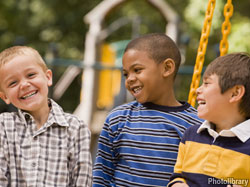(ARA) – For most families, summertime means outdoor fun. Day camps, trips to the swim club and the playground make summer a time for kids to let loose and have fun. But what about kids with chronic diseases that may require extra attention? Can they enjoy the same summer activities as their peers?
More often than not, the answer is yes.
One example is kids who have hemophilia, a disease in which the blood doesn’t clot properly. Several decades ago, treatment options for hemophilia were limited and had serious risks. Kids with the condition often found themselves on the sidelines to avoid getting injured. Today, safe and effective treatments, as well as a wealth of knowledge about the disease, have made it possible for people with hemophilia to live normal lives – including playing sports.
Pat Torrey is the director and facilitator of Leading Edge, an adventure education program for kids with bleeding disorders such as hemophilia. Torrey recommends the following tips for parents, coaches, camp counselors and other adults who may be responsible for a child with hemophilia this summer. These are just general tips – a doctor is always the best source of information.
* Use the same commonsense rules you would with any child – warm up, stay hydrated, cool down. Any child is less likely to take a tumble – and more likely to bounce back quickly – if his body is primed for play.
* Encourage your child to be active and try new things. Physical activity is critical for kids with hemophilia. It can help improve self-esteem, keep muscles and joints limber and prevent excess weight gain.
* Encourage your child to learn about and manage his disorder. Some kids, especially teens, may not want to deal with having a disease, and therefore may not take simple steps to prevent a bleed. When appropriate, encourage the child to take control of his disease so he can be active and safe.
* Know whether your child is open about his condition. Some adolescents with hemophilia may choose not to tell their peers about their condition. It’s important to know his preference and respect it either way.
* Get to know your child and his unique disease. Hemophilia is different for everyone, and a child’s ability to participate in activities can vary depending on disease severity, types of treatment, history of symptoms and many other factors.
* Know your child’s problem areas. Many kids with hemophilia have specific parts of their body that tend to get injured – a right ankle or left knee, for example. Keep an eye out for injuries to that part of the body.
* Be clear with the child and his parents about the risks of the sport. It’s important for families dealing with hemophilia to know the potential risks of any activity so they can plan ahead and take necessary precautions.
* Recognize that some sports may not be appropriate. Most kids with hemophilia can participate in the same sports as their peers. In general, activities like soccer, baseball, hiking, skiing, and ropes courses are fine. On the other hand, high-contact sports such as football may be too risky, depending on the individual. Parents should always check with a doctor before their child starts a new sport.
* Stop and evaluate after an injury. Monitor the child after a fall and check in regularly to see how he’s doing. If he’s favoring a specific arm or leg, it could mean the other side of his body is in pain. If you think medical attention may be necessary, err on the side of caution.
With these tips in mind, you can help ensure a safe and fun summer for everyone. Always consult a child’s parents or a doctor for specific information about the child’s condition. To learn more about hemophilia, visit www.hemophiliavillage.com.
Courtesy of ARAcontent

